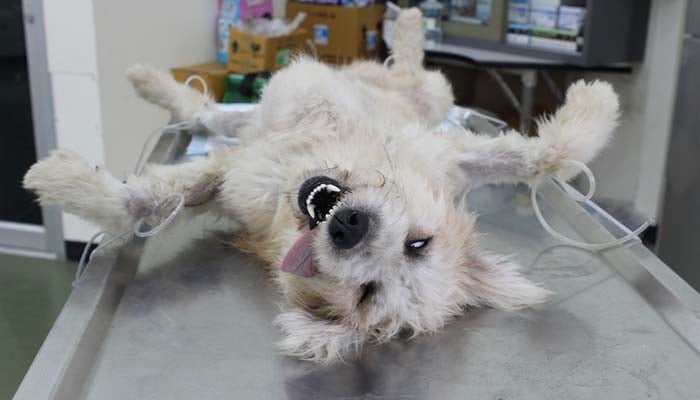Just like humans, dogs experience seizures. These seizures can be the result of numerous root causes and are categorized based on various characteristics. Most pet owners are only aware of epileptic seizures, but there are far more causes of this condition than epilepsy alone. Here's what you need to know about all different types of dog seizures.
What Causes of Seizures in Dogs?
Just like us, our dogs may experience seizures for a variety of reasons. While it’s impossible to pinpoint them all, some of them include:
- Epilepsy
- Kidney failure
- Liver disease
- Brain trauma or head injury
- Toxins or poisons
- Brain tumors
- Unregulated blood sugar
- Stroke
- Encephalitis
- Neurological disease
- Infection
The Different Phases of Dog Seizures
Dog seizures are generally characterized by phases. These include the prodrome, the pre-ictal phase, the ictal phase, and the post-ictal phase.
Prodrome
The prodromal phase of a seizure happens before a seizure occurs and often serves as an advanced warning of upcoming seizure activity. Not all dogs experience a prodromal period before seizure activity.
The prodromal phase can begin anywhere from days to hours before the actual seizure takes place. Prodromal symptoms are generally limited emotional changes, for example, you may notice that your dog just doesn’t “seem like themselves”.
Pre-Ictal Phase
The pre-ictal phase of a seizure is also called the “aura” phase and it takes place shortly before a seizure.
The pre-ictal phase can take place anywhere from hours to seconds before seizure activity begins. This phase is something of an “emergency broadcast” that something is wrong and if recognized, it should be a sign to get your dog into a safe space and/or prepare for seizure activity.
Pre-ictal symptoms are similar to prodromal symptoms but also include behavioral changes – your dog may become clingy and nervous – and physical changes – your dog may tremble, whine, or salivate.
Ictal Phase
The ictal phase of a seizure is the seizure activity itself. Depending on the type of seizure and cause, this phase of activity can last from seconds to minutes.
Any new seizure activity or seizure activity lasting longer than five minutes should receive veterinary attention right away. Symptoms of a seizure depend on the type of seizure (we'll cover that information below).
Post-Ictal Phase
The post-ictal phase is the period of time immediately after your dog’s seizure activity has ended. This phase can last anywhere from minutes to days but the length of the post-ictal phase does not have a direct correlation to the severity of the seizure.
The post-ictal phase is best understood when compared to a hangover in humans. During a hangover, your body is trying to cope with the aftereffects of the alcohol you have ingested and you feel those effects physically and mentally. Similarly, when your dog’s body has been through the trauma of a seizure, they are going to feel the effects of that trauma physically and mentally as their body tries to cope with what has just happened.
During the post-ictal phase of a seizure, your dog may exhibit numerous symptoms including:
- Lack of coordination
- Excessive salivation
- Disorientation
- Confusion
- Restlessness
- Pacing
- Temporary vision loss
Types of Seizures in Dogs
There are three main classifications of seizures in dogs, which include generalized seizures, partial seizures, and partial seizures with secondary generalization.
1. Generalized Seizures
Generalized seizures happen when both sides of your dog’s brain experience an electrical “misfiring”. When this happens, your dog will often fall to the floor, they may or may not lose consciousness, and their legs can either stiffen and extend or twitch and jerk.
During generalized seizures, your dog may stop breathing so it is important to monitor them closely.
After approximately 10 to 30 seconds, your dog may begin to chomp their teeth, paddle their legs, salivate, whine, lose bowel or bladder control, or bark. Your dog’s pupils will also dilate. The average length of a generalized seizure is between 30 seconds to a minute and a half; despite this, it can take much longer for your dog to fully recover (24 hours+).
A generalized seizure is subcategorized as a tonic-clonic, tonic, clonic, myoclonic, atonic, and absence seizure.
Tonic Seizures
This type of dog seizure happens quite suddenly and most often occurs when your dog is sleepy or already sleeping and in the non-REM stages of sleep.
During a tonic seizure, your dog will begin flexing and straightening their limbs. This type of seizure generally lasts for less than one minute.
Atonic Seizures
Atonic seizures are usually seen in dogs that also experience tonic seizures. During atonic seizures, your dog loses all muscle tone and goes limp while losing consciousness for a couple of seconds.
After this type of seizure, your dog will regain consciousness and recover surprisingly quickly.
Atonic seizures can easily be confused with syncope by dog owners, but the two have very different causes. Where atonic seizures are related to electrical activity abnormalities in the brain, syncope occurs as a result of insufficient blood flow to the brain as a result of a sudden drop in blood pressure.
Clonic Seizures
This type of seizure is not seen very frequently, but when it is seen it usually happens as the result of high body temperatures.
During a clonic seizure, your dog may or may not lose consciousness and begin to convulse as their muscles contract and relax periodically. Clonic seizures generally last for around a minute.
Tonic-Clonic Seizures
This type of seizure is commonly referred to as a “Grand Mal seizure” and is fairly common. Dogs that experience tonic-clonic seizures almost always have symptoms before the seizure that indicate its approach. These symptoms include:
- Weakness
- Irritability
- Anxiety
- Dizziness
- Changes in mood
Tonic-clonic seizures are most frequently associated with toxicity, low blood sugar, or low sodium levels. The average tonic-clonic seizure lasts for one minute and is made up of a tonic stage and a clonic stage.
Myoclonic Seizures
During myoclonic seizures, your dog will almost always remain conscious and aware of their surroundings. This type of seizure is characterized by:
- Rapidly contracting muscles
- Twitching facial muscles
- Jerking pelvic muscles
This type of seizure is most commonly seen in young dogs that are affected by epilepsy.
Myoclonic seizures usually last just a few seconds and can appear as a single seizure or a cluster of seizures. It isn’t uncommon for dog owners to confuse myoclonic seizures for muscle jerks or tremors.
Absence Seizures
Absence seizures are more commonly referred to as “petit mal seizures” and they are quite rare in dogs. Although rare, when petit mal seizures do occur, it’s important to head to your veterinarian because it is possible for them to turn into grand mal seizures.
Symptoms of this type of seizure may include:
- Lip licking
- Head shaking
- Eye rolling
- Body trembling
- Quieted activity characterized by just blinking
Absence seizures usually last less than one minute.
2. Partial Seizures
Partial seizures are also referred to as focal seizures in dogs. A partial seizure results from an electrical misfiring in a localized area of the brain. During a partial seizure, you may notice your dog twitch or jerk on one side of their body, or their face may twitch or jerk on one side. Your dog may also curl their body to one side or turn their head to one side and they may have abnormal movement in just one limb.
It is possible for partial seizures to become generalized seizures. There are two subcategories of partial seizures – simple partial seizures and complex partial seizures.
Simple Partial Seizures
During a simple partial seizure, your dog may exhibit any of the following symptoms:
- Dilated pupils
- Involuntary movements
- Growling or barking
- Balance difficulties
- Vision changes
- Hallucinations
- Hearing changes
- Biting at the air
- Behaving irrationally (for example, being afraid when there is nothing to be afraid of)
During a simple partial seizure, your dog will likely be completely conscious and aware of their surroundings. This type of seizure can last from seconds to minutes although symptoms a simple partial seizure may linger for hours.
Complex Partial Seizures
It is quite common for a dog to stare fixedly without moving and then experience a range of peculiar behaviors just before a complex partial seizure. Once the seizure begins, they may experience any of the following symptoms:
- Salivating
- Chewing or chomping
- Aggression
- Cowering
- Hysterical running
- Vomiting
- Diarrhea
- Biting at their flank
- Growling or barking
- Unusual thirst
- Unusual appetite
During a complex partial seizure, it isn’t likely that your dog will lose full consciousness, but they may seem “out of it”. This type of seizure can last from seconds to minutes although symptoms of a complex partial seizure can linger for hours.
3. Cluster Seizures
Cluster seizures occur when your dog experiences multiple seizures within a short period of time, but they have periods of consciousness between seizures. Cluster seizures require immediate veterinary attention because they can be life-threatening.
4. Status Epilepticus
Status epilepticus occurs when your dog experiences a single seizure that lasts for 30 minutes or more, or when they experience multiple seizures in a short time without gaining consciousness between them.
This is an exceptionally dangerous situation for your dog. Without immediate veterinary help to stop this type of seizure with anti-convulsants and supportive care, your dog may experience brain damage or even die.
Status epilepticus does not only happen to dogs with a history of epilepsy, but it is also possible for a dog that has never had a seizure to experience status epilepticus too.
What Should You Do If Your Dog Has a Seizure
If your dog has a seizure the biggest thing that you can do to help the situation is to stay calm! We know, this is a difficult thing to do even if your dog has had seizures before, but it’s important to keep your head so that you can relay accurate information to your vet.
The next thing you want to do is ensure that your dog is somewhere safe and they cannot hurt themselves during their seizure. Don’t try to move your dog but move anything out of the way that they could hurt themselves on. You can also place a cushion under your dog’s head to make them more comfortable and talk to them to let them know that you are present.
Take note of the time so that you can time your dog’s seizure.
NEVER put your hands near your dog’s mouth while they are having a seizure, it is an old wives tale that people and animals can swallow their tongues during seizures but there is a high risk you will be accidentally bitten.
If your dog’s seizure lasts for more than a couple of minutes, they run the risk over overheating. You can lessen this risk by soaking towels in cool water and placing them under your dog’s armpits, thighs, and on their neck. DO NOT point a fan directly at them as this can cause them to “gulp” air.
 Write down the length of your dog’s seizure, the symptoms they experienced, and any preceding factors that may have induced seizure activity.
Write down the length of your dog’s seizure, the symptoms they experienced, and any preceding factors that may have induced seizure activity.
When your dog is stabilized, contact your veterinarian immediately and let them know what has happened. If seizures are “routine” for your dog, your vet may not require you to come in right away, but if this is a first seizure, an unusual seizure, a clustered seizure, or a lengthy seizure, they will likely want you to come in right away.
When to See an Emergency Vet for Seizure Activity
Seizures don’t always happen when your regular veterinarian is open for business. If your vet is closed and your dog has their first seizure, an unusual seizure, a cluster of seizures, or a seizure that lasts for more than a few minutes, get to the vet or emergency vet immediately and DO NOT wait for your vet clinic to open.
READ NEXT: 11 Most Fatal Dog Health Conditions















